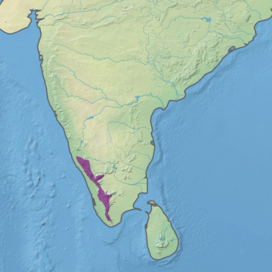South Western Ghats montane rain forests
| South Western Ghats montane rain forests | |
|---|---|
Nilgiri mountains | |
 Ecoregion territory (in purple) | |
| Ecology | |
| Realm | Indomalayan |
| Biome | Tropical and subtropical moist broadleaf forests |
| Borders | |
| Geography | |
| Area | 22,500 km2 (8,700 sq mi) |
| Country | India |
| States | |
| Elevation | 1,000 to 2,695 m (3,281 to 8,842 ft) |
| Rivers | Periyar River |
| Climate type | tropical |
| Conservation | |
| Conservation status | critical/endangered[1] |
| Protected | 5,998 km2 (2,316 sq mi)%[2] |
The South Western Ghats montane rain forests is an ecoregion in South India, covering the southern portion of the Western Ghats in Karnataka, Kerala and Tamil Nadu at elevations from 1,000 to 2,695 m (3,281 to 8,842 ft). Annual rainfall in this ecoregion exceeds 2,800 mm (110 in).[3]
Setting
The
The southern portion of the Western Ghats contains the highest peaks in the range, notably Anamudi in Kerala, at 2695 meters elevation. The Ghats intercept the moisture-laden monsoon winds off the Arabian Sea, and the average annual precipitation exceeds 2,800 mm. The northeast monsoon from October to November supplements the June to September southwest monsoon. The South Western Ghats are the wettest portion of peninsular India, and are surrounded by drier ecoregions to the east and north.[3]
Protected areas
As of 1997, this ecoregion encompassed the following 16 protected areas with an area of 3,250 km2 (1,250 sq mi):[3]
- in Karnataka: Talakaveri Wildlife Sanctuary with 250 km2 (97 sq mi), Brahmagiri Wildlife Sanctuary with 190 km2 (73 sq mi), Pushpagiri Wildlife Sanctuary with 60 km (37 mi)
- in Kerala: Parambikulam Wildlife Sanctuary with 260 km2 (100 sq mi), Karimpuzha National Park with 230 km2 (89 sq mi), Silent Valley National Park with 110 km2 (42 sq mi), Idukki Wildlife Sanctuary with 80 km2 (31 sq mi), Eravikulam National Park with 97 km2 (37 sq mi), Aralam Wildlife Sanctuary with 50 km2 (19 sq mi), Peppara Wildlife Sanctuarywith 40 km2 (15 sq mi)
- in Tamil Nadu: Megamalai Wildlife Sanctuary with 120 km2 (46 sq mi) and Mukurthi National Park with 60 km2 (23 sq mi)[citation needed]
As of 2017, the total size of protected areas within this ecoregion amounted to 5,998 km2 (2,316 sq mi), equivalent to 27% of the ecoregion's extent. Another 62% is forested but outside protected areas.[2]
Several of the protected areas in the northern portion are included within the Nilgiri Biosphere Reserve, and the Agasthyamala Biosphere Reserve covers the southern portion.[citation needed]
Flora

The cool and moist climate, high rainfall, and variety of microclimates brought about by differences in elevation and exposure supports lush and diverse forests; 35% of the plant species are endemic to the ecoregion. Moist evergreen
The other major habitat type in this ecoregion is the
Fauna
References
- ^ Rawat, G.S.; Desai, A.; Somanathan, H. & Wikramanayake, E.D. (2002). "South Western Ghats montane rain forests". Terrestrial Ecoregions. World Wildlife Fund.
- ^ PMID 28608869.
- ^ ISBN 978-1559-639-23-1.
External links
 Media related to South Western Ghats montane rain forests at Wikimedia Commons
Media related to South Western Ghats montane rain forests at Wikimedia Commons


